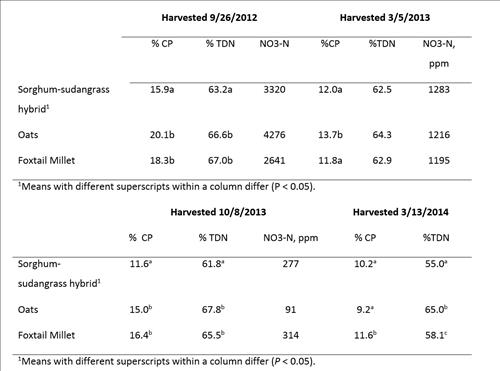Cattle producers often have concerns about loss of quality if forage is left standing and not baled immediately.
December 2, 2016

Many beef cattle producers are interested in planting annual forages in the summer for later use in the winter, according to the University of Nebraska-Lincoln. The question often surfaces about whether to bale the forage or let the cattle graze the forage later in the year.
Producers interested in grazing the mature standing forage want to avoid the expense of baling and moving the forage, but producers may have concerns about the loss of forage quality if the forage isn't baled right away.

To address these concerns, research was conducted in a two-year study at the High Plains Ag Lab near Sidney, Neb. Forages were planted after irrigated wheat was harvested, and some additional water was applied to the forage crop. Therefore, the total tonnage and the quality produced would likely vary if the forage was planted earlier in the summer and on dryland acres.
However, the interesting result was how minimally the quality of these forages changed over the winter (Table). While some nutrient loss did occur, all forages studied in both years maintained enough quality to support rumen function without additional protein. The available nutrients would also support gain of about 1.0-1.5 lb. per day on weaned calves if the quantity was adequate.
The first year of the study experienced a severe drought, and nitrate levels were above the recommended 1,600 parts per million for safe grazing when harvested just prior to a frost. However, the nitrate levels dissipated over the winter and reached a safe level by March.
Producers should always sample forages for nutrient content prior to grazing to know if it will be adequate for the targeted cattle performance.
More detailed information from this study is in the 2016 "Beef Report" at http://beef.unl.edu/documents/2016-beef-report/24-2016-Annual-Forages-following-Irrigated-Winter-Wheat.pdf.
Don't just put horses away for winter
Horses can't be put away for the winter just because they're not being used. Horse health and care is a year-round process. Good nutrition, vaccination schedules, parasite control and other care should be continued throughout the winter, according to a news release from Iowa State University Extension & Outreach.
Dale Miller, Marion County program director and equine educator with Iowa State University Extension & Outreach, offers tips for proper equine winter care and management as well as some reminders about winter horse needs for good ventilation, feed and water management and exercise. Miller adapted the recommendations from a publication by Dr. R.D. Scoggins, a retired equine extension veterinarian with the University of Illinois.
* Ventilation. Fresh air and/or good ventilation are major requirements for horses kept inside. Judging from their own perception of what's comfortable, humans tend to close up barns too tightly. Horses can tolerate considerable cold if they can move around and are dry. Avoid drafts, but allow sufficient air exchange to move stale air, humidity and ammonia out of the environment.
Keeping stalls clean is necessary to keep ammonia levels low. Studies at the University of Illinois have shown that ammonia concentrates roughly 18 in. above the surface of the bedding (where the horse's head is located when it lies down). High levels can cause a decrease in athletic ability and overall quality of life. This emphasizes the need to keep stalls cleaned regularly.
* Feed and water management. Horses need free-choice, good-quality hay, loose salt and minerals and water heated to 45-65°F. Several studies have shown that warming water to 60°F will increase water consumption by 40-100%. Dehydration (lack of water) is the number-one cause of impaction colic in horses. Cold weather, combined with a diet of dry feed, also can cause impaction colic. Warming the water is much more effective than feeding bran, linseed meal or other so-called laxative diets.
Most horses will not require grain if the hay is of good quality. Hay generates more heat than grain does during digestion and, thus, is more helpful in maintaining body heat during cold weather. However, the extra energy provided by grain may be needed to maintain normal weight when the horse is exposed to severe low temperatures or deep snow.
* Exercise. Attempting to maintain some level of physical fitness will decrease the time needed to get the horse in shape for the coming season. Exercising three times a week for an hour at a walk and trot will help maintain physical fitness. Use this time to increase flexibility by doing suppling exercises at the walk and trot to reduce the incidence of lameness.
When working horses in cold weather, warm them up slowly and thoroughly before asking them to do serious work. In cold weather, most horses are more "cinchy" when being saddled, so be sure to move them before mounting.
Hot horses need to be cooled thoroughly and then brushed to stand the hair up again before turning them out. Fluffy hair traps air and keeps the horse warm; hair that's plastered down flat or wet lets body heat escape.
During all seasons, horses are generally better suited to being outside where they have an area for adequate exercise and access to a windbreak or run-in shed for shelter. Horses that are not in competition should have shoes pulled and hooves trimmed regularly, about every six weeks. Let their hair coat grow out for natural protection during the winter.
Anticipating weather changes and adapting exercise schedules and feeding programs accordingly allows horses to be enjoyed all year long.
You May Also Like


.png?width=300&auto=webp&quality=80&disable=upscale)
